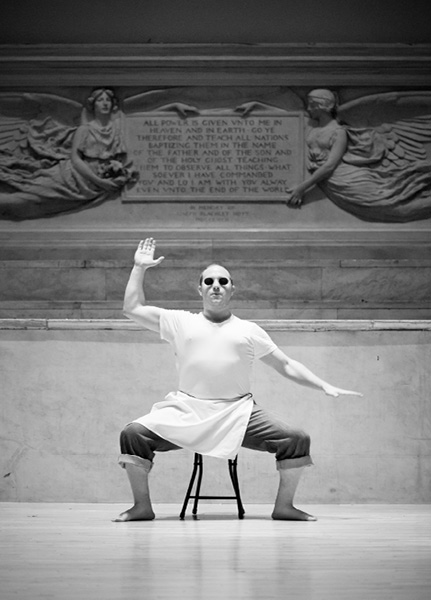
THE DESERT, PART ONE: RITE OF THE BUTCHER
first performed on
February 21, 2011
Movement Research at the Judson Church, New York, NY
performed 0 times in 2011
BEN SPATZ, URBAN RESEARCH THEATER
New York, NY
064401140b064401140e064401140n064401140@064401140u064401140r064401140b064401140a064401140n064401140r064401140e064401140s064401140e064401140a064401140r064401140c064401140h064401140t064401140h064401140e064401140a064401140t064401140e064401140r064401140.064401140c064401140o064401140m
urbanresearchtheater.com
THE DESERT, PART ONE: RITE OF THE BUTCHER
BEN SPATZ, URBAN RESEARCH THEATER
Fragments of the first part of “The Desert” solo performance trilogy. Concrete elements: blue jeans, blue glasses, white butcher’s apron, white t-shirt, black folding chair. Song fragments. Blind eyes. Pattern of running in space. Sequence of actions with chair: sit, dance, worship, etc. Seated gestural actions: martial, cutting, making. Poetic text, beginning as follows: “To create, from nothing, new proportion, new dimension, little houses, little people, made of color…” Actions while singing: reach, caress, wrestle, grapple, roll. Improvised dance. Running out from the space.
Problem: How to place a crafted flow of embodied action (physical actions, invented songs) in relation to contemporary imagery and themes? The underlying practice is concrete, even technical, in its structuring of the performer’s body and breath. When placed in a performative situation, it appears uncommonly abstract. Not physically virtuosic enough to be “dance”-not melodically complex enough to be “music”-more rigorously scored than “performance art”-my own background is in theater, but this is no longer recognizable as theater. It is between disciplines.
How then to reintegrate this profoundly personal embodied practice of song and action within a frame of text, narrative, and character? How to go from a concrete (for the performer) and abstract (for the witness) “song cycle” to a “solo performance” that reads as compelling event rather than esoteric ritual? How to use convention to provide a doorway into the unconventional without erasing the radical difference of the source? How to offer the results of research as a product in a strategic way that can ultimately support what is not yet visible?
Some of these questions were answered, at least temporarily, between this showing in February and the official premiere of “Rite of the Butcher” at the United Solo Festival in November. But the more “open” version at Judson Church remains valuable to me as a crossroads, marking a moment in which different possibilities coexisted side by side-before the decisive directorial choices had been made. There is something pure in its lack of theatrical framing, its refusal to offer more than active presence through an evocative embodied score.